Unit 8 Lingling helps her parents 教学设计(3个课时)
文档属性
| 名称 | Unit 8 Lingling helps her parents 教学设计(3个课时) | 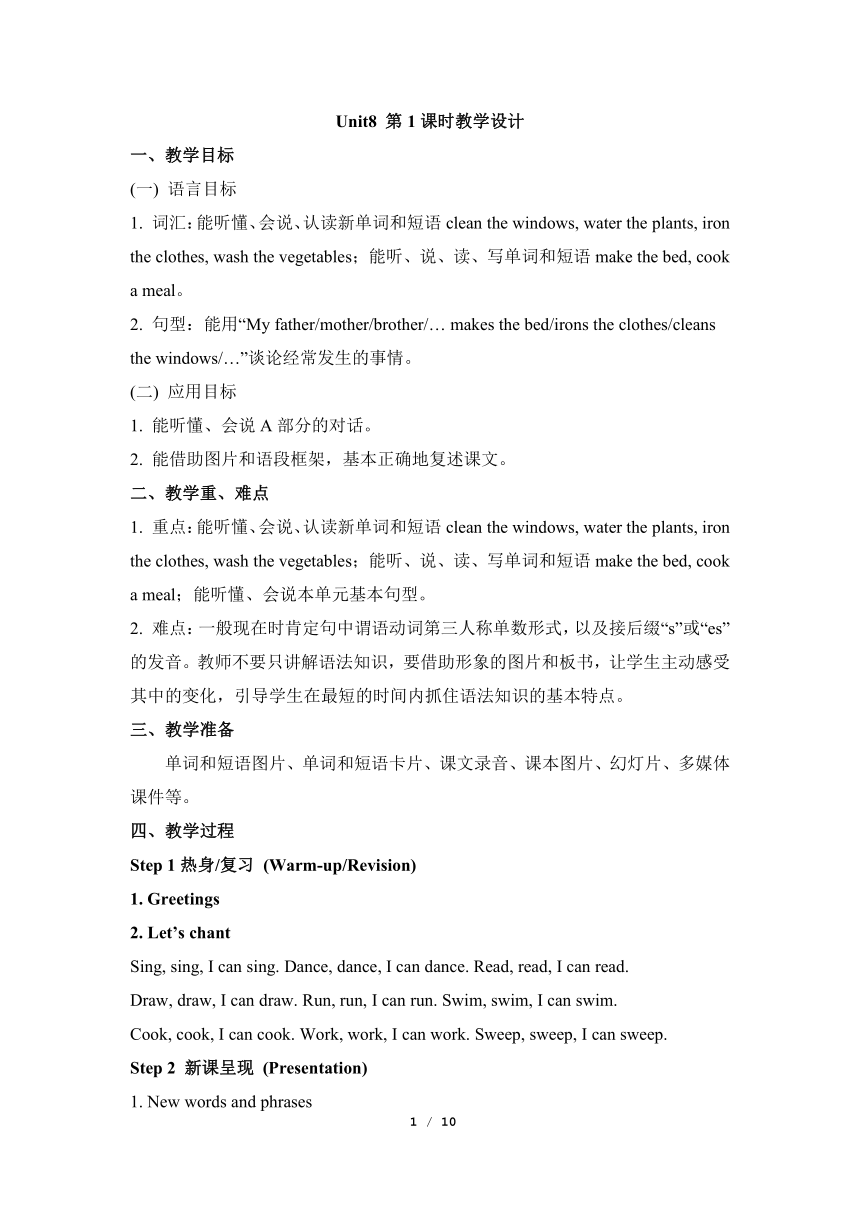 | |
| 格式 | zip | ||
| 文件大小 | 1.0MB | ||
| 资源类型 | 教案 | ||
| 版本资源 | 湘少版 | ||
| 科目 | 英语 | ||
| 更新时间 | 2018-06-09 18:32:55 | ||
图片预览

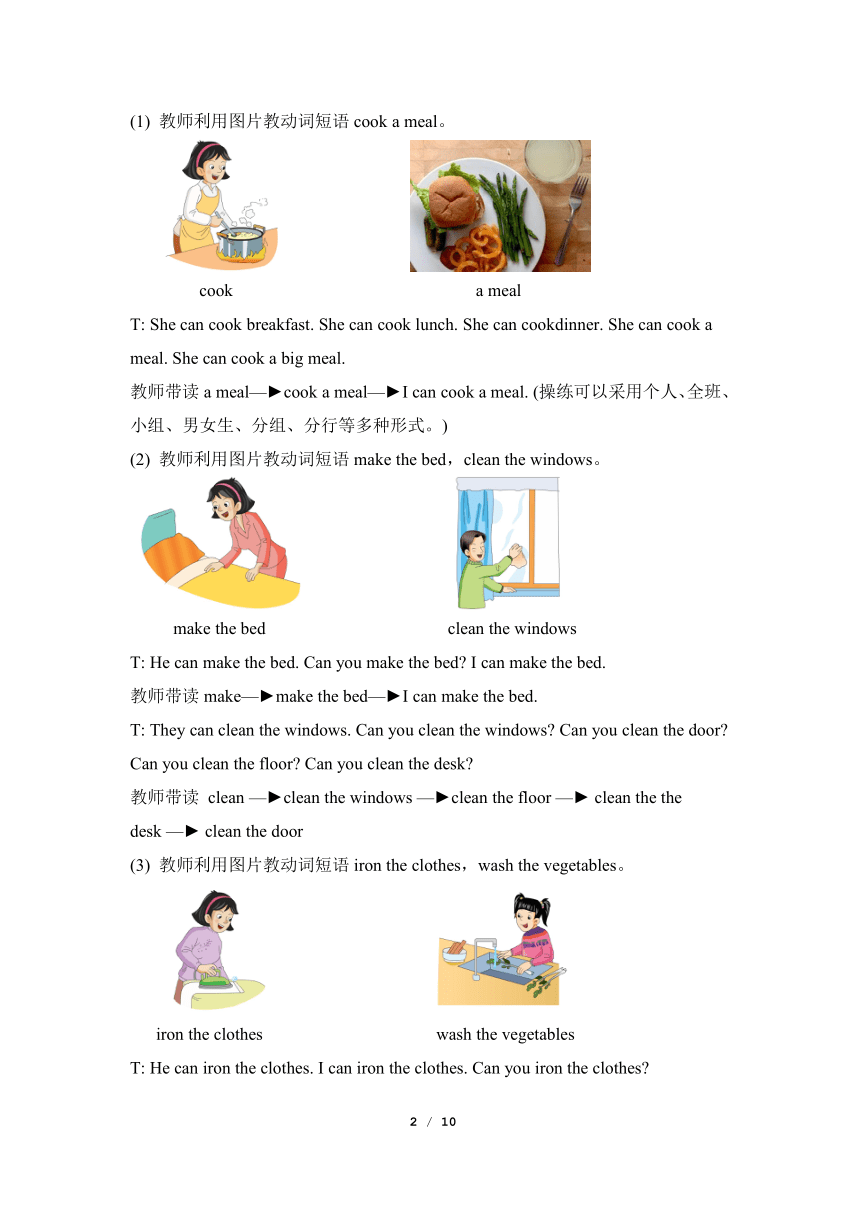
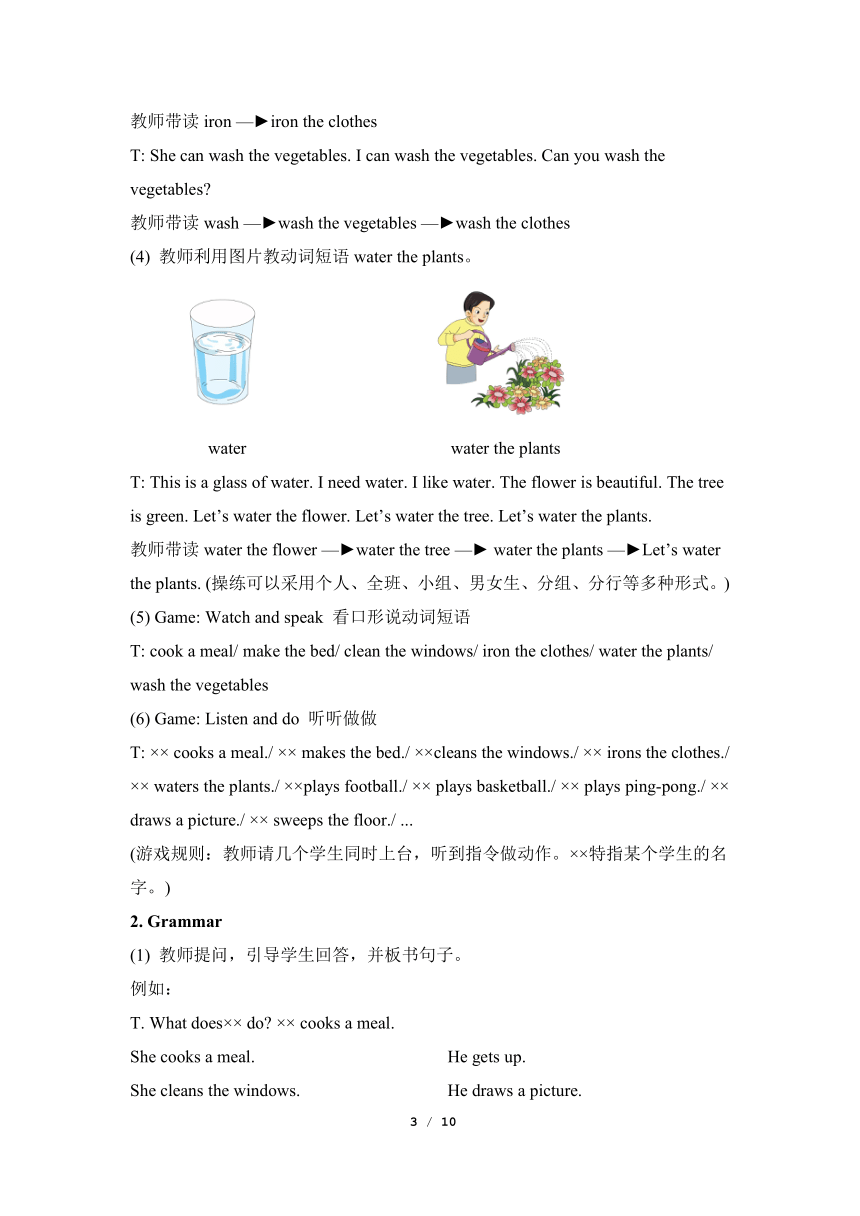
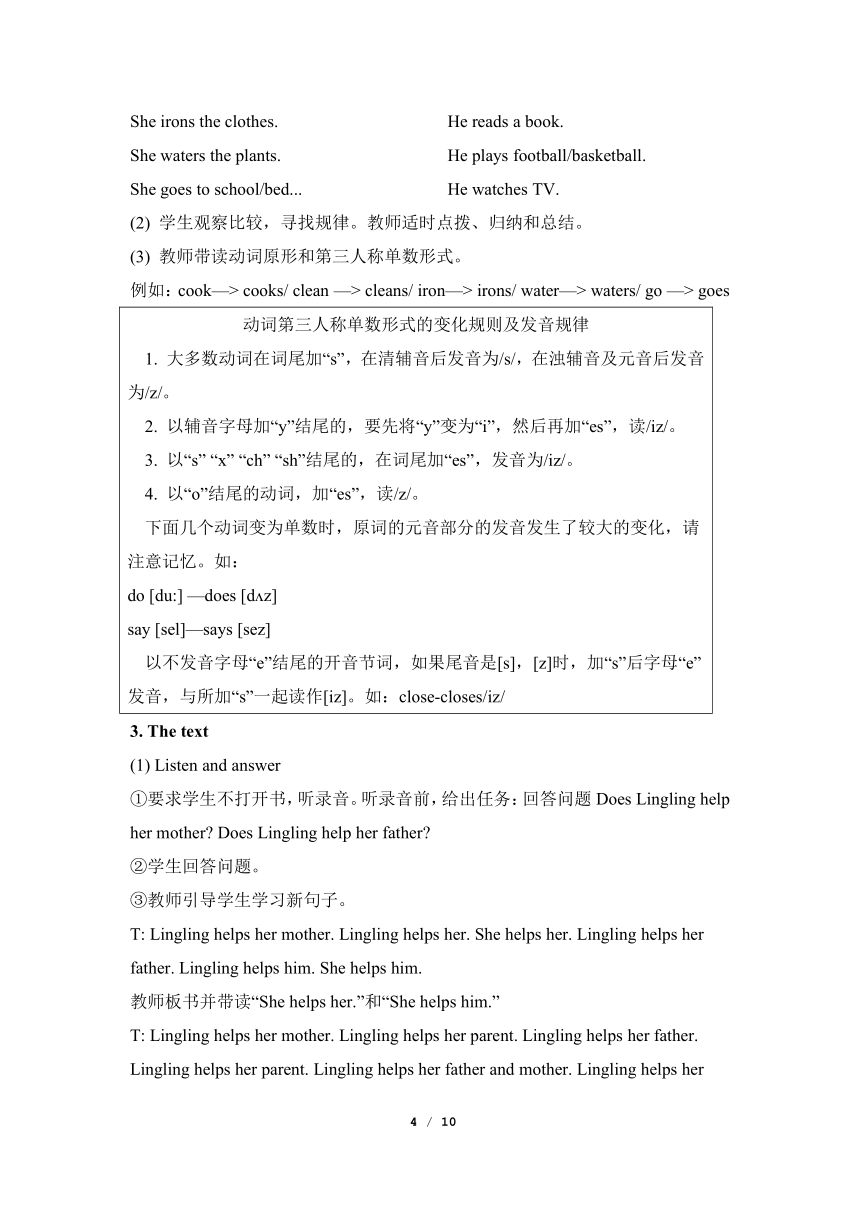
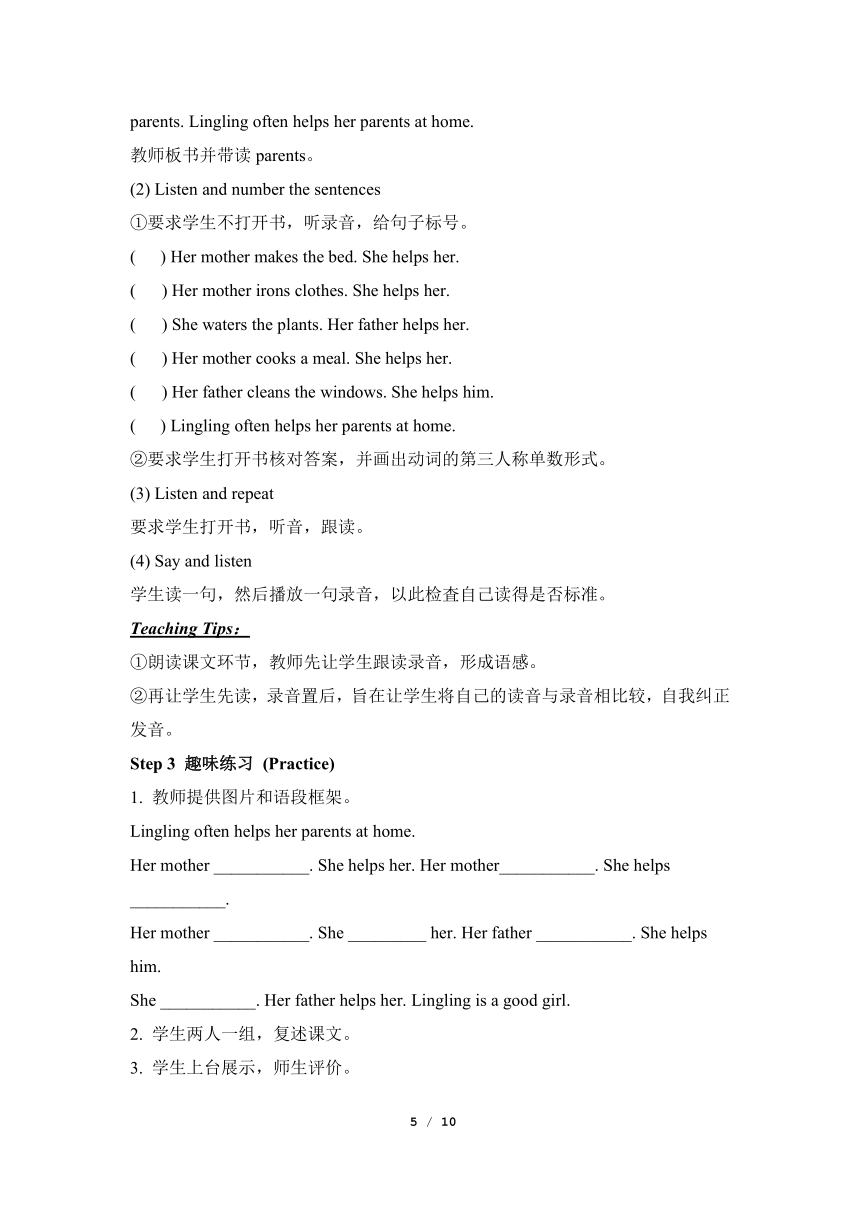
文档简介
Unit8 第1课时教学设计
一、教学目标
(一) 语言目标
1. 词汇:能听懂、会说、认读新单词和短语clean the windows, water the plants, iron the clothes, wash the vegetables;能听、说、读、写单词和短语make the bed, cook a meal。
2. 句型:能用“My father/mother/brother/… makes the bed/irons the clothes/cleans the windows/…”谈论经常发生的事情。
(二) 应用目标
1. 能听懂、会说A部分的对话。
2. 能借助图片和语段框架,基本正确地复述课文。
二、教学重、难点
1. 重点:能听懂、会说、认读新单词和短语clean the windows, water the plants, iron the clothes, wash the vegetables;能听、说、读、写单词和短语make the bed, cook a meal;能听懂、会说本单元基本句型。
2. 难点:一般现在时肯定句中谓语动词第三人称单数形式,以及接后缀“s”或“es”的发音。教师不要只讲解语法知识,要借助形象的图片和板书,让学生主动感受其中的变化,引导学生在最短的时间内抓住语法知识的基本特点。
三、教学准备
单词和短语图片、单词和短语卡片、课文录音、课本图片、幻灯片、多媒体课件等。
四、教学过程
Step 1热身/复习 (Warm-up/Revision)
1. Greetings
2. Let’s chant
Sing, sing, I can sing. Dance, dance, I can dance. Read, read, I can read.
Draw, draw, I can draw. Run, run, I can run. Swim, swim, I can swim.
Cook, cook, I can cook. Work, work, I can work. Sweep, sweep, I can sweep.
Step 2 新课呈现 (Presentation)
1. New words and phrases
(1) 教师利用图片教动词短语cook a meal。
cook a meal
T: She can cook breakfast. She can cook lunch. She can cookdinner. She can cook a meal. She can cook a big meal.
教师带读a meal—?cook a meal—?I can cook a meal. (操练可以采用个人、全班、小组、男女生、分组、分行等多种形式。)
(2) 教师利用图片教动词短语make the bed,clean the windows。
make the bed clean the windows
T: He can make the bed. Can you make the bed? I can make the bed.
教师带读make—?make the bed—?I can make the bed.
T: They can clean the windows. Can you clean the windows? Can you clean the door? Can you clean the floor? Can you clean the desk?
教师带读 clean —?clean the windows —?clean the floor —? clean the the desk —? clean the door
(3) 教师利用图片教动词短语iron the clothes,wash the vegetables。
iron the clothes wash the vegetables
T: He can iron the clothes. I can iron the clothes. Can you iron the clothes?
教师带读iron —?iron the clothes
T: She can wash the vegetables. I can wash the vegetables. Can you wash the vegetables?
教师带读wash —?wash the vegetables —?wash the clothes
(4) 教师利用图片教动词短语water the plants。
water water the plants
T: This is a glass of water. I need water. I like water. The flower is beautiful. The tree is green. Let’s water the flower. Let’s water the tree. Let’s water the plants.
教师带读water the flower —?water the tree —? water the plants —?Let’s water the plants. (操练可以采用个人、全班、小组、男女生、分组、分行等多种形式。)
(5) Game: Watch and speak 看口形说动词短语
T: cook a meal/ make the bed/ clean the windows/ iron the clothes/ water the plants/ wash the vegetables
(6) Game: Listen and do 听听做做
T: ×× cooks a meal./ ×× makes the bed./ ××cleans the windows./ ×× irons the clothes./ ×× waters the plants./ ××plays football./ ×× plays basketball./ ×× plays ping-pong./ ×× draws a picture./ ×× sweeps the floor./ ...
(游戏规则:教师请几个学生同时上台,听到指令做动作。××特指某个学生的名字。)
2. Grammar
(1) 教师提问,引导学生回答,并板书句子。
例如:
T. What does×× do? ×× cooks a meal.
She cooks a meal. He gets up.
She cleans the windows. He draws a picture.
She irons the clothes. He reads a book.
She waters the plants. He plays football/basketball.
She goes to school/bed... He watches TV.
(2) 学生观察比较,寻找规律。教师适时点拨、归纳和总结。
(3) 教师带读动词原形和第三人称单数形式。
例如:cook—> cooks/ clean —> cleans/ iron—> irons/ water—> waters/ go —> goes
动词第三人称单数形式的变化规则及发音规律
1. 大多数动词在词尾加“s”,在清辅音后发音为/s/,在浊辅音及元音后发音为/z/。
2. 以辅音字母加“y”结尾的,要先将“y”变为“i”,然后再加“es”,读/iz/。
3. 以“s” “x” “ch” “sh”结尾的,在词尾加“es”,发音为/iz/。
4. 以“o”结尾的动词,加“es”,读/z/。
下面几个动词变为单数时,原词的元音部分的发音发生了较大的变化,请注意记忆。如:
do [du:] —does [d?z]
say [sel]—says [sez]
以不发音字母“e”结尾的开音节词,如果尾音是[s],[z]时,加“s”后字母“e”发音,与所加“s”一起读作[iz]。如:close-closes/iz/
3. The text
(1) Listen and answer
①要求学生不打开书,听录音。听录音前,给出任务:回答问题Does Lingling help her mother? Does Lingling help her father?
②学生回答问题。
③教师引导学生学习新句子。
T: Lingling helps her mother. Lingling helps her. She helps her. Lingling helps her father. Lingling helps him. She helps him.
教师板书并带读“She helps her.”和“She helps him.”
T: Lingling helps her mother. Lingling helps her parent. Lingling helps her father. Lingling helps her parent. Lingling helps her father and mother. Lingling helps her parents. Lingling often helps her parents at home.
教师板书并带读parents。
(2) Listen and number the sentences
①要求学生不打开书,听录音,给句子标号。
( ) Her mother makes the bed. She helps her.
( ) Her mother irons clothes. She helps her.
( ) She waters the plants. Her father helps her.
( ) Her mother cooks a meal. She helps her.
( ) Her father cleans the windows. She helps him.
( ) Lingling often helps her parents at home.
②要求学生打开书核对答案,并画出动词的第三人称单数形式。
(3) Listen and repeat
要求学生打开书,听音,跟读。
(4) Say and listen
学生读一句,然后播放一句录音,以此检査自己读得是否标准。
Teaching Tips:
①朗读课文环节,教师先让学生跟读录音,形成语感。
②再让学生先读,录音置后,旨在让学生将自己的读音与录音相比较,自我纠正发音。
Step 3 趣味练习 (Practice)
1. 教师提供图片和语段框架。
Lingling often helps her parents at home.
Her mother ___________. She helps her. Her mother___________. She helps ___________.
Her mother ___________. She _________ her. Her father ___________. She helps him.
She ___________. Her father helps her. Lingling is a good girl.
2. 学生两人一组,复述课文。
3. 学生上台展示,师生评价。
Step 4 作业布置 (Homework)
1. 听录音,读对话,并试着表演对话。
2. 制作9张动词短语卡片。(要求一面写动词短语原形,另一面写动词短语第三人称单数形式。)Unit8 第2课时教学设计
一、教学目标
(一) 语言目标
1. 词汇:复习和巩固已学单词和动词短语。
2. 句型:能正确运用句型“What do you do at home?” “I help my mother/water the plants/ …”谈论日常行为。
(二) 应用目标
1. 能在设定的情境中熟练运用句型谈论自己和他人的日常生活行为。
2. 能借助图片,阅读和理解D部分的短文。
3. 在阅读训练过程中,逐步了解和掌握一些阅读方法,如怎样默读。
二、教学重、难点
1. 重点:阅读和理解短文。
2. 难点:细读短文后完成表格,并根据所填内容的提示,复述短文。
三、教学准备
单词和短语图片、单词和短语卡片、课文录音、课本图片、幻灯片、多媒体课件等。
四、教学过程
Step 1热身/复习(Warm-up/Revision)
1. Greetings
2. Revision
Game: Bingo!
游戏规则:学生将上次家庭作业制作的9张动词短语卡片,按照3×3的样式摆在课桌上,教师任意说三个动词短语,如:make the bed, cook a meal, clean the windows。将这三张卡片摆放在了一条线上的学生就大声说:“Bing!”
Step 2主题任务(Task)
1. 开展一个小组调查。学生拿出教师事先分发的调查表,运用本节课所学内容与同组成员进行简单的口语交际。所用的句型与调查表如下:
What do you do at home?
I …
Wang Wei
Liu Ling
Zhang Peng
make the bed
√
√
iron the clothes
√
clean the windows
√
cook a meal
√
wash the vegetables
water the plants
√
√
sweep the floor
√
2. 展示学生的调查结果,并操练句型“xx makes the bed/cooks a meal/...”
Step 3 阅读拓展(Let’s Read)
1. 看图听课文(有条件的学校可以看视频),回答问题:Who are they?
(看图听音,引导学生了解文章大意,培养学生捕捉关键信息的能力。)
2. 第一遍阅读短文。
要求学生默读,用笔圈出与家务劳动有关的动词短语,然后看图连线。
3. 第二遍阅读短文。
要求学生默读,并画出自己不懂的单词和句子,然后将生词写在黑板上。师生一起解决生词困难。
Teaching Tips:
在阅读教学中适量增加默读训练,让学生注意提高默读速度并掌握默读的一般规则:
①尽量一次读一个短语块;
②默读时避免嘴唇的蠕动或低声诵读;
③尽量从语境中推测生词的意思;
④扫读时目光应迅速从前一个句子移到下一个句子,避免频繁回视或指读等。
4. 第三遍阅读短文。
学生与同伴合作阅读,完成下列表格。
What does Lanlan’s family usually do at home?
5. 听录音,跟读。
6. 复述短文。
(1) 教师提供图片和语段框架。
I want to be a good child. I help my ________ and ________ at home every day.
My mother ________. I help her. My father ________. I help him. My mother ________. I ________ her. My mother ________. I ________.
(2) 学生两人一组,复述课文。
(3) 学生上台展示,师生评价。
Step 4 作业布置(Homework)
1. 听录音,读短文,并试着复述短文。
2. 填写课本第38页的表格。
Unit8 第3课时教学设计
一、教学目标
(一) 语言目标
1. 词汇:复习和巩固已学单词。
2. 句型:能进一步熟练地运用句型谈论日常行为。
(二) 应用目标
1. 能借助图片和提完成E部分的看图作文。
2. 能用已学的动词短语创编F部分的歌谣。
二、教学重、难点
1. 重点:完成E部分的看图作文。
2. 难点:动词第三人称单数形式的发音和书写。
三、教学准备
图片、实物、单词卡片、课文录音、课本图片、幻灯片、多媒体课件等。
四、教学过程
Step 1 热身/复习(Warm up/Revision)
1. Greetings
2. Revision
Game:抢读单词
游戏规则:教师将全班分为几组,然后逐个出示动词短语卡片,让学生抢读。
例如:
Game: Act and say
游戏规则:全班学生分为几组。教师请几名学生轮流上台表演扫地等家务劳动的动作,台下的学生说出相应的动词短语,猜对的小组得分,看哪个小组得分最高。
Step 2 新课呈现(Presentation)
1. 教师依次出示E部分的四张图片。
2. 每张图片请学生先看图说话,再写话。
图1:Monday
My mother washes the dishes. I help her.
图2:Tuesday
My mother washes the clothes. I help her.
图3:Wednesday
My father sweeps the floor. I help him.
图4:Thursday
My mother cooks a meal. I help her.
板书:Friday
T: What do you do at home?
4. 让学生自由表达。
5. 学生上台板书创作的句子,教师及时评价。
Step 3 歌谣演练(Let’s chant)
1. 听歌摇Come and help me,小声跟读。
2. 朗读歌摇,配以有趣的动作。
3. 男女生分组进行歌谣表演比赛。
Step 4 趣味练习(Practice)
1. 学生两人一组,用已学的动词短语创编F部分的歌谣。鼓励学生大胆想象,灵活运用。
2. 新编歌谣大比拼。让学生就改编的歌谣进行汇报演出,评选最佳创意奖。
Step 5 作业布置(Homework)
1. 听3?5遍录音,背诵A部分。
2. 用已学过的句型和动词短语写3~5句自己平时做家务劳动的句子。
3. 每天主动帮家人做力所能及的家务劳动。
本单元知识拓展(Expansion)
美国孩子的家务清单
6~7岁:能在父母的帮助下洗碗盘,能独立打扫自己的房间。
7?12岁:能做简单的饭;帮忙洗车;吸地擦地;清理洗手间、廊所;扫树叶,扫雪;会用洗衣机和烘干机;把垃圾箱搬到门口街上(有垃圾车来收)。
13岁以上:能换灯泡;换吸尘器里的垃圾袋;擦玻(里外两面);清理冰箱;清理炉台和烤箱;做饭;列出要买的东西的清单;洗衣服(全过程,包括洗衣、烘干衣物、叠衣以及放回衣柜);修理草坪。
一、教学目标
(一) 语言目标
1. 词汇:能听懂、会说、认读新单词和短语clean the windows, water the plants, iron the clothes, wash the vegetables;能听、说、读、写单词和短语make the bed, cook a meal。
2. 句型:能用“My father/mother/brother/… makes the bed/irons the clothes/cleans the windows/…”谈论经常发生的事情。
(二) 应用目标
1. 能听懂、会说A部分的对话。
2. 能借助图片和语段框架,基本正确地复述课文。
二、教学重、难点
1. 重点:能听懂、会说、认读新单词和短语clean the windows, water the plants, iron the clothes, wash the vegetables;能听、说、读、写单词和短语make the bed, cook a meal;能听懂、会说本单元基本句型。
2. 难点:一般现在时肯定句中谓语动词第三人称单数形式,以及接后缀“s”或“es”的发音。教师不要只讲解语法知识,要借助形象的图片和板书,让学生主动感受其中的变化,引导学生在最短的时间内抓住语法知识的基本特点。
三、教学准备
单词和短语图片、单词和短语卡片、课文录音、课本图片、幻灯片、多媒体课件等。
四、教学过程
Step 1热身/复习 (Warm-up/Revision)
1. Greetings
2. Let’s chant
Sing, sing, I can sing. Dance, dance, I can dance. Read, read, I can read.
Draw, draw, I can draw. Run, run, I can run. Swim, swim, I can swim.
Cook, cook, I can cook. Work, work, I can work. Sweep, sweep, I can sweep.
Step 2 新课呈现 (Presentation)
1. New words and phrases
(1) 教师利用图片教动词短语cook a meal。
cook a meal
T: She can cook breakfast. She can cook lunch. She can cookdinner. She can cook a meal. She can cook a big meal.
教师带读a meal—?cook a meal—?I can cook a meal. (操练可以采用个人、全班、小组、男女生、分组、分行等多种形式。)
(2) 教师利用图片教动词短语make the bed,clean the windows。
make the bed clean the windows
T: He can make the bed. Can you make the bed? I can make the bed.
教师带读make—?make the bed—?I can make the bed.
T: They can clean the windows. Can you clean the windows? Can you clean the door? Can you clean the floor? Can you clean the desk?
教师带读 clean —?clean the windows —?clean the floor —? clean the the desk —? clean the door
(3) 教师利用图片教动词短语iron the clothes,wash the vegetables。
iron the clothes wash the vegetables
T: He can iron the clothes. I can iron the clothes. Can you iron the clothes?
教师带读iron —?iron the clothes
T: She can wash the vegetables. I can wash the vegetables. Can you wash the vegetables?
教师带读wash —?wash the vegetables —?wash the clothes
(4) 教师利用图片教动词短语water the plants。
water water the plants
T: This is a glass of water. I need water. I like water. The flower is beautiful. The tree is green. Let’s water the flower. Let’s water the tree. Let’s water the plants.
教师带读water the flower —?water the tree —? water the plants —?Let’s water the plants. (操练可以采用个人、全班、小组、男女生、分组、分行等多种形式。)
(5) Game: Watch and speak 看口形说动词短语
T: cook a meal/ make the bed/ clean the windows/ iron the clothes/ water the plants/ wash the vegetables
(6) Game: Listen and do 听听做做
T: ×× cooks a meal./ ×× makes the bed./ ××cleans the windows./ ×× irons the clothes./ ×× waters the plants./ ××plays football./ ×× plays basketball./ ×× plays ping-pong./ ×× draws a picture./ ×× sweeps the floor./ ...
(游戏规则:教师请几个学生同时上台,听到指令做动作。××特指某个学生的名字。)
2. Grammar
(1) 教师提问,引导学生回答,并板书句子。
例如:
T. What does×× do? ×× cooks a meal.
She cooks a meal. He gets up.
She cleans the windows. He draws a picture.
She irons the clothes. He reads a book.
She waters the plants. He plays football/basketball.
She goes to school/bed... He watches TV.
(2) 学生观察比较,寻找规律。教师适时点拨、归纳和总结。
(3) 教师带读动词原形和第三人称单数形式。
例如:cook—> cooks/ clean —> cleans/ iron—> irons/ water—> waters/ go —> goes
动词第三人称单数形式的变化规则及发音规律
1. 大多数动词在词尾加“s”,在清辅音后发音为/s/,在浊辅音及元音后发音为/z/。
2. 以辅音字母加“y”结尾的,要先将“y”变为“i”,然后再加“es”,读/iz/。
3. 以“s” “x” “ch” “sh”结尾的,在词尾加“es”,发音为/iz/。
4. 以“o”结尾的动词,加“es”,读/z/。
下面几个动词变为单数时,原词的元音部分的发音发生了较大的变化,请注意记忆。如:
do [du:] —does [d?z]
say [sel]—says [sez]
以不发音字母“e”结尾的开音节词,如果尾音是[s],[z]时,加“s”后字母“e”发音,与所加“s”一起读作[iz]。如:close-closes/iz/
3. The text
(1) Listen and answer
①要求学生不打开书,听录音。听录音前,给出任务:回答问题Does Lingling help her mother? Does Lingling help her father?
②学生回答问题。
③教师引导学生学习新句子。
T: Lingling helps her mother. Lingling helps her. She helps her. Lingling helps her father. Lingling helps him. She helps him.
教师板书并带读“She helps her.”和“She helps him.”
T: Lingling helps her mother. Lingling helps her parent. Lingling helps her father. Lingling helps her parent. Lingling helps her father and mother. Lingling helps her parents. Lingling often helps her parents at home.
教师板书并带读parents。
(2) Listen and number the sentences
①要求学生不打开书,听录音,给句子标号。
( ) Her mother makes the bed. She helps her.
( ) Her mother irons clothes. She helps her.
( ) She waters the plants. Her father helps her.
( ) Her mother cooks a meal. She helps her.
( ) Her father cleans the windows. She helps him.
( ) Lingling often helps her parents at home.
②要求学生打开书核对答案,并画出动词的第三人称单数形式。
(3) Listen and repeat
要求学生打开书,听音,跟读。
(4) Say and listen
学生读一句,然后播放一句录音,以此检査自己读得是否标准。
Teaching Tips:
①朗读课文环节,教师先让学生跟读录音,形成语感。
②再让学生先读,录音置后,旨在让学生将自己的读音与录音相比较,自我纠正发音。
Step 3 趣味练习 (Practice)
1. 教师提供图片和语段框架。
Lingling often helps her parents at home.
Her mother ___________. She helps her. Her mother___________. She helps ___________.
Her mother ___________. She _________ her. Her father ___________. She helps him.
She ___________. Her father helps her. Lingling is a good girl.
2. 学生两人一组,复述课文。
3. 学生上台展示,师生评价。
Step 4 作业布置 (Homework)
1. 听录音,读对话,并试着表演对话。
2. 制作9张动词短语卡片。(要求一面写动词短语原形,另一面写动词短语第三人称单数形式。)Unit8 第2课时教学设计
一、教学目标
(一) 语言目标
1. 词汇:复习和巩固已学单词和动词短语。
2. 句型:能正确运用句型“What do you do at home?” “I help my mother/water the plants/ …”谈论日常行为。
(二) 应用目标
1. 能在设定的情境中熟练运用句型谈论自己和他人的日常生活行为。
2. 能借助图片,阅读和理解D部分的短文。
3. 在阅读训练过程中,逐步了解和掌握一些阅读方法,如怎样默读。
二、教学重、难点
1. 重点:阅读和理解短文。
2. 难点:细读短文后完成表格,并根据所填内容的提示,复述短文。
三、教学准备
单词和短语图片、单词和短语卡片、课文录音、课本图片、幻灯片、多媒体课件等。
四、教学过程
Step 1热身/复习(Warm-up/Revision)
1. Greetings
2. Revision
Game: Bingo!
游戏规则:学生将上次家庭作业制作的9张动词短语卡片,按照3×3的样式摆在课桌上,教师任意说三个动词短语,如:make the bed, cook a meal, clean the windows。将这三张卡片摆放在了一条线上的学生就大声说:“Bing!”
Step 2主题任务(Task)
1. 开展一个小组调查。学生拿出教师事先分发的调查表,运用本节课所学内容与同组成员进行简单的口语交际。所用的句型与调查表如下:
What do you do at home?
I …
Wang Wei
Liu Ling
Zhang Peng
make the bed
√
√
iron the clothes
√
clean the windows
√
cook a meal
√
wash the vegetables
water the plants
√
√
sweep the floor
√
2. 展示学生的调查结果,并操练句型“xx makes the bed/cooks a meal/...”
Step 3 阅读拓展(Let’s Read)
1. 看图听课文(有条件的学校可以看视频),回答问题:Who are they?
(看图听音,引导学生了解文章大意,培养学生捕捉关键信息的能力。)
2. 第一遍阅读短文。
要求学生默读,用笔圈出与家务劳动有关的动词短语,然后看图连线。
3. 第二遍阅读短文。
要求学生默读,并画出自己不懂的单词和句子,然后将生词写在黑板上。师生一起解决生词困难。
Teaching Tips:
在阅读教学中适量增加默读训练,让学生注意提高默读速度并掌握默读的一般规则:
①尽量一次读一个短语块;
②默读时避免嘴唇的蠕动或低声诵读;
③尽量从语境中推测生词的意思;
④扫读时目光应迅速从前一个句子移到下一个句子,避免频繁回视或指读等。
4. 第三遍阅读短文。
学生与同伴合作阅读,完成下列表格。
What does Lanlan’s family usually do at home?
5. 听录音,跟读。
6. 复述短文。
(1) 教师提供图片和语段框架。
I want to be a good child. I help my ________ and ________ at home every day.
My mother ________. I help her. My father ________. I help him. My mother ________. I ________ her. My mother ________. I ________.
(2) 学生两人一组,复述课文。
(3) 学生上台展示,师生评价。
Step 4 作业布置(Homework)
1. 听录音,读短文,并试着复述短文。
2. 填写课本第38页的表格。
Unit8 第3课时教学设计
一、教学目标
(一) 语言目标
1. 词汇:复习和巩固已学单词。
2. 句型:能进一步熟练地运用句型谈论日常行为。
(二) 应用目标
1. 能借助图片和提完成E部分的看图作文。
2. 能用已学的动词短语创编F部分的歌谣。
二、教学重、难点
1. 重点:完成E部分的看图作文。
2. 难点:动词第三人称单数形式的发音和书写。
三、教学准备
图片、实物、单词卡片、课文录音、课本图片、幻灯片、多媒体课件等。
四、教学过程
Step 1 热身/复习(Warm up/Revision)
1. Greetings
2. Revision
Game:抢读单词
游戏规则:教师将全班分为几组,然后逐个出示动词短语卡片,让学生抢读。
例如:
Game: Act and say
游戏规则:全班学生分为几组。教师请几名学生轮流上台表演扫地等家务劳动的动作,台下的学生说出相应的动词短语,猜对的小组得分,看哪个小组得分最高。
Step 2 新课呈现(Presentation)
1. 教师依次出示E部分的四张图片。
2. 每张图片请学生先看图说话,再写话。
图1:Monday
My mother washes the dishes. I help her.
图2:Tuesday
My mother washes the clothes. I help her.
图3:Wednesday
My father sweeps the floor. I help him.
图4:Thursday
My mother cooks a meal. I help her.
板书:Friday
T: What do you do at home?
4. 让学生自由表达。
5. 学生上台板书创作的句子,教师及时评价。
Step 3 歌谣演练(Let’s chant)
1. 听歌摇Come and help me,小声跟读。
2. 朗读歌摇,配以有趣的动作。
3. 男女生分组进行歌谣表演比赛。
Step 4 趣味练习(Practice)
1. 学生两人一组,用已学的动词短语创编F部分的歌谣。鼓励学生大胆想象,灵活运用。
2. 新编歌谣大比拼。让学生就改编的歌谣进行汇报演出,评选最佳创意奖。
Step 5 作业布置(Homework)
1. 听3?5遍录音,背诵A部分。
2. 用已学过的句型和动词短语写3~5句自己平时做家务劳动的句子。
3. 每天主动帮家人做力所能及的家务劳动。
本单元知识拓展(Expansion)
美国孩子的家务清单
6~7岁:能在父母的帮助下洗碗盘,能独立打扫自己的房间。
7?12岁:能做简单的饭;帮忙洗车;吸地擦地;清理洗手间、廊所;扫树叶,扫雪;会用洗衣机和烘干机;把垃圾箱搬到门口街上(有垃圾车来收)。
13岁以上:能换灯泡;换吸尘器里的垃圾袋;擦玻(里外两面);清理冰箱;清理炉台和烤箱;做饭;列出要买的东西的清单;洗衣服(全过程,包括洗衣、烘干衣物、叠衣以及放回衣柜);修理草坪。
同课章节目录
- Unit 1 What does she look like?
- Unit 2 I'd like a hamburge
- Unit 3 Do you want some rice?
- Unit 4 Can I use your pencil,please?
- Unit 5 Can I have a pet?
- Unit 6 Which one do you want?
- Unit 7 What time do you get up?
- Unit 8 Lingling helps her parents
- Unit 9 What's your hobby?
- Unit 10 What does that sign mean?
- Unit 11 I'm sorry.
- Unit 12 The Spring Festival
